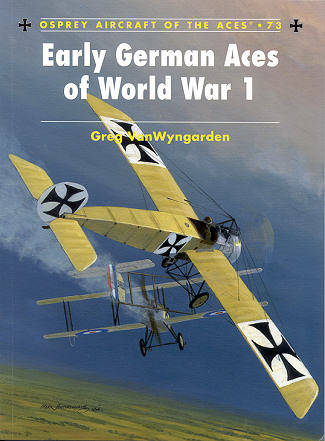 When we
think of the war in the air during WWI, we think of von Richthofen, Rickenbacker,
Ball and others. But these were men that made their name later in the war. When
the war started, there were no armed aircraft and no fighters.
When we
think of the war in the air during WWI, we think of von Richthofen, Rickenbacker,
Ball and others. But these were men that made their name later in the war. When
the war started, there were no armed aircraft and no fighters.|
Title: |
Early German Aces of WWI |
|
Author: |
Greg VanWyngarden |
|
Publisher/Distributor |
Osprey Publishing |
|
Price |
$20.95 MSRP |
|
Reviewer: |
|
| Notes: |
96 pages, 7¼ x 9¼ inches, softbound ISBN: 1-84176-997-5 |
 When we
think of the war in the air during WWI, we think of von Richthofen, Rickenbacker,
Ball and others. But these were men that made their name later in the war. When
the war started, there were no armed aircraft and no fighters.
When we
think of the war in the air during WWI, we think of von Richthofen, Rickenbacker,
Ball and others. But these were men that made their name later in the war. When
the war started, there were no armed aircraft and no fighters.
The planes that were in the air at the time were reconnaissance types and those with cameras, wanting to know what the other side was doing. Early armament was a rifle or pistol carried by the observer, for airborne machine guns did not exist. Those available were too heavy and so these weapons had to be developed.
There was also the problem of mounting the gun so as to not shoot off one's own propeller. When single seat scouts were finally developed, they either mounted the gun outside the prop arc or used steel deflector plate on the back of the prop. It was Fokker who has credit for finally developing a synchronizer to stop the gun from firing when the prop was in the line of fire. It was workable with two guns, but three was asking too much for the technology of the time. Even then, there were still cases where the mechanism malfunctioned and a prop blade was cut off, usually causing a crash and death of the pilot.
It was this ability to synchronize the gun that gave birth to the first real fighter/pursuit aircraft; the Fokker Eindekker, a lightweight monoplane design that was flown by all the early German aces. So effective was this aircraft, that during a large portion of 1915 and 1916, these aircraft were called the 'Fokker Scourge'.
It was with these aircraft that the first aces were to gain their victories. Names as Boelke, Udet, Buddecke, Lefflers, Immelmann and others were to become heroes and household names in Germany and other parts of the world.
During this time, targets were not as plentiful as in later years so it was not unheard of for these men to go for quite a while without scoring a victory. As with everything technological, the Eindekker was soon obsolescent, though still potent in the hands of a skilled pilot and replaced by biplanes of greater maneuverability by Fokker, Halberstadt and Albatross.
The author takes us through the time where the fighters were simply part of a normal unit along with recce planes and bombers until the development of special fighter units in 1916. The stories of these men are told through the able pen of author Van Vyngarden and capably illustrated by Harry Dempsey in 32 profiles. Period photos of the men and machines of the time add to the sense of history one gets while reading.
It is a superb look at the early years and development of fighter aircraft, ever-changing tactice and the men who flew them. A book that you'll find as thoroughly intriguing as did I and one I can recommend without reservation.
November 2006
For more on the complete line of Osprey books, visit www.ospreypublishing.com or contact them at Osprey Direct, PO Box 140, Wellingborough, Northants, NN8 2FA, UK. In the US, it is Osprey Direct at 44-02 23rd St, Suite 219, Long Island City, NY 11101., where you can get a catalogue of available books.
If you would like your product reviewed fairly and quickly by a site that has over 325,000 visitors a month, please contact me or see other details in the Note to Contributors.